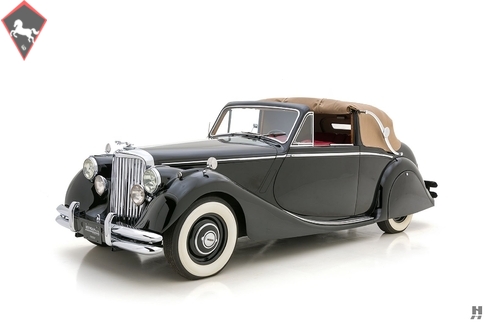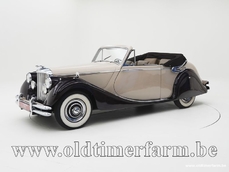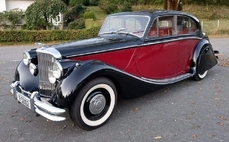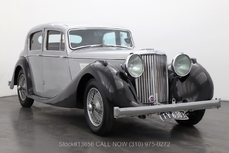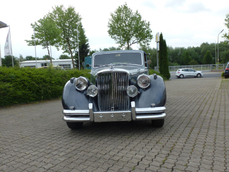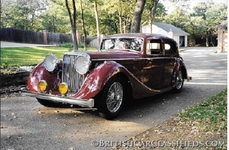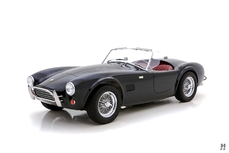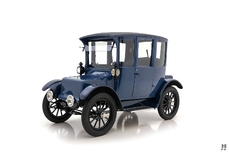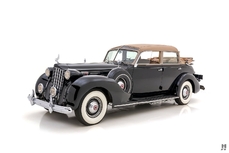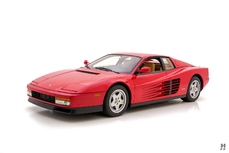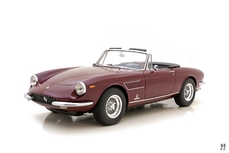Jaguar MkV Drophead Coupe 1951
General description :
The 1948 London Motor Show was a momentous occasion for Sir William Lyons and his newly re-named Jaguar Cars. The London show was famously the event where the world first saw the sensational new XK120 sports car, with its sublime feline styling and exotic twin-cam engine. Sharing the stand, and the limelight, was Jaguar’s latest saloon model, the Mark V.
While it was somewhat in the shadow of the XK120 at the Motor Show, the new Mark V had its own distinctions. The Mark V was the first all-new Jaguar model since the end of World War II. Since it beat the XK120 to production, it was also the first Jaguar to feature hydraulic brakes, independent front suspension, and pressed steel wheels. For the anoraks among us, the Mk V was the first production car to use sealed ball-joints in the front end, a design featured in virtually every mass-market vehicle since. The elegantly styled Mark V retained a touch of traditional English formality inspired by the pre-war models, and buyers had the choice of either a closed four-door saloon or the equally handsome open two-door drophead-coupe. Power came from either a 2 ½-litre or 3 ½-litre single-cam pushrod inline six-cylinder engine, derived from a Standard unit used in the Mk IV and pre-war SS models. Despite all of its milestones, the Mark V was produced for just 28 months, barely topping 10,000 units before the XK-powered Mk VII replaced it (Jaguar skipped over “Mk VI” because of its use by Bentley). Collectors covet these rare and beautiful Jaguars for their elegant baroque styling, luxurious accommodations, and delicate balance of sporting performance with long-distance touring comfort. In powerful 3 ½-litre form, the luxurious Mark V Drophead was akin to an XK120 for the family man.
This lovely Mark V 3-position drophead is a desirable 3 ½-litre model, presented with a well-maintained older restoration, finished in its original color scheme of black over red upholstery. According to the Jaguar Heritage Certificate, this car left the Jaguar works in Coventry on October 10, 1950, destined for James L Cooke Motors of Toronto, Ontario, Canada. In 1959, Mr. Harold Allsop of Willowdale, Ontario, purchased this car to accompany his two-seat Cord. Later, he began to restore the Jaguar, but when it took time away from his Cord, he set the MkV aside. Finally, when he retired at age 70, Harold revived the Jaguar project, and poured a great deal of time and energy into its restoration.
The drophead since changed hands since the Allsops restored it, and as offered today, it is nicely presented with good black paintwork displaying some minor imperfections from age and occasional use. Black rear wheel spats and the low, wide stance give it a distinctly sporting and purposeful appearance. Body fit is very good, and the car is detailed with a mix of restored and excellent original chrome, with period-correct touches, including a leaper mascot and twin fog lamps. Opening the bottom-hinged boot lid reveals a capacious luggage compartment and the extensive factory tool kit, which is complete minus one wrench.
The cabin is restored to original specification, using high quality red hides and wool carpet sourced from England. The leather remains quite supple and attractive with just a touch of broken-in character on the seating surfaces. Wilton wool carpets are similarly excellent, and the only deviation from standard is the tan canvas soft top in place of the original black. Restored Smiths gauges sit in the central instrument panel, which is finished in a burl walnut veneer. The lacquer finish on the wood shows some lifting and patina in places, but is in good condition otherwise.
Under the bonnet is a correct specification 3 ½-litre OHV inline-six with twin SU carburetors. It features the correct air cleaner and aluminum plenum, and the presentation is tidy, with authentic detailing and many period-correct fittings. The engine pairs with a four-speed manual gearbox with floor-mounted gearshift, enhancing the sporting, purposeful character.
This is an appealing example of the most desirable Mark V Jaguar variant, restored for the personal enjoyment of the family that loved it for 54 years, and now offered with an inviting character that encourages continued use.
Offers welcome and trades considered
1951 Jaguar MkV Drophead Coupe is listed for sale on ClassicDigest in St. Louis by Hyman Ltd. for $69500.
Car Facts
Car type : Car Make : Jaguar Model : MkV Model Version : Drophead Coupe Engine size : 0.0 Model Year : 1951 Sub type : Coupé Location : Missouri Vehicle Registration : Undefined
69500 $
Market Prices for Jaguar MkV from 2023 to 2025
Months
Jaguar MkV Selling Time to Price Correlation
0
6
12
18
24
30
36
42
48
54
0
50000
100000
150000
200000
ClassicDigest Market-O-Meter for Jaguar MkV
Moderate Blue Chip Chart Busters
People who viewed this Jaguar MkV also viewed similar Jaguar listed at ClassicDigest
Other cars listed for sale by this dealer
About Jaguar
Ah, the story of Jaguar, from its early days as the SS Cars Ltd. to its pinnacle with the D-type, and the street-going evolution in the form of the iconic E-type. There's something quintessentially British about this tale, and I'll narrate it as a British journalist might.In the Beginnings:
Our journey into the world of Jaguar begins in the 1930s, when a company known as SS Cars Ltd. emerged. Despite the unfortunate coincidence of their initials with the rising political tensions in Europe, they started producing stylish and performance-oriented cars. The SS 100, introduced in 1936, was a symbol of elegance and speed, setting the stage for what would become Jaguar.
The Birth of Jaguar:
As the shadows of World War II loomed, SS Cars Ltd. wisely decided to disassociate themselves from the SS initials. Thus, in 1945, they officially became Jaguar Cars Ltd., a name that would soon be synonymous with British luxury and performance.
The XK Series:
Jaguar's post-war era brought us the XK 120, a true sensation in 1948. With its sleek design and a powerful 3.4-liter inline-six engine, it became the world's fastest production car. The XK 120 was the blueprint for what lay ahead – Jaguars that blended style with speed in a uniquely British fashion.
The D-type Dominance:
Then came the D-type, a true racing legend. Introduced in 1954, it won Le Mans three times in the 1950s, showcasing Jaguar's engineering prowess. With its innovative monocoque construction and the iconic fin at the back, the D-type was the apex of Jaguar's motorsport success.
The E-type Emergence:
But the true turning point arrived in 1961 with the introduction of the E-type, often described by Enzo Ferrari as "the most beautiful car ever made." Its long bonnet, curvaceous body, and a 3.8-liter engine delivering exhilarating performance made it an instant classic. The E-type was not just a car; it was a work of art on wheels, and it could hit 150 mph on the road.
Street and Racing Success:
The E-type's beauty was matched by its capability on the track. The lightweight E-types were particularly successful in various racing events, cementing Jaguar's reputation as a force to be reckoned with in motorsport.
The Age of Refinement:
As we delve deeper into the Jaguar story, we find that the 1950s and 1960s were an age of refinement and expansion. Alongside the magnificent D-type and the E-type's iconic emergence, Jaguar introduced models that further solidified its reputation for luxury and performance.
The MK2:
In the late 1950s, Jaguar unveiled the MK2, a sports sedan that combined elegance with power. This sleek four-door saloon was a favorite of bank robbers and law enforcement alike, thanks to its exceptional speed and handling. The MK2 was a symbol of Jaguar's ability to blend sophistication with performance and had a successful racing career as well.
The XJ6:
Fast forward to 1968, and Jaguar launched a car that would define luxury saloons for decades to come – the XJ6. It was a masterpiece of engineering and design, featuring a smooth inline-six engine, independent rear suspension, and a spacious, beautifully appointed interior. The XJ6 was a symbol of British elegance and provided a ride so smooth that it seemed to glide over the road. It became the flagship model for Jaguar and set the standard for luxury saloons, showcasing a level of refinement that left competitors in awe.
The Blend of Classic and Modern:
While the MK2 and XJ6 represented the evolution of Jaguar's saloon cars, they maintained the brand's commitment to performance and luxury. These cars didn't just belong on the racetrack; they were equally at home cruising down the grand boulevards or gliding through the English countryside.
The Challenges of Change:
However, as the 1970s arrived, Jaguar, like many British automakers, faced financial challenges and changes in ownership. The British Leyland era brought both opportunities and struggles, as the brand navigated through various mergers and transitions.
Nevertheless, the legacy of the MK2 and XJ6, along with the D-type and E-type, continues to define Jaguar as a manufacturer that combines timeless elegance with a spirit of performance. These classic models, whether driven on winding roads or parked as collectors' treasures, serve as a testament to Jaguar's enduring presence in the world of automotive excellence.
The Jaguar story, from its early days as SS Cars Ltd. to the creation of automotive icons like the E-type, MK2, and XJ6, is a journey that reflects the very essence of British motoring – a blend of luxury, power, and style that continues to captivate enthusiasts and connoisseurs alike.
